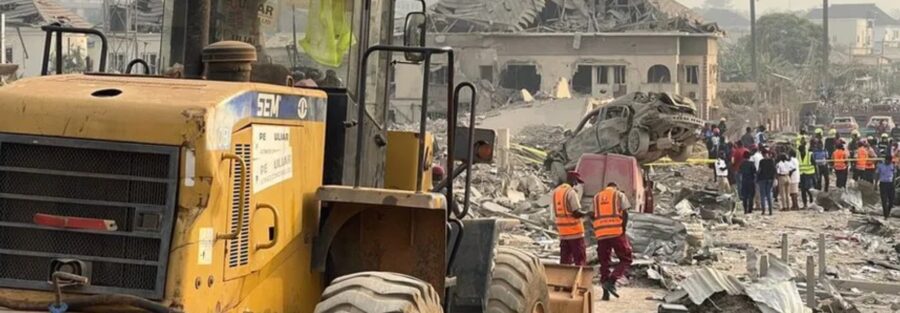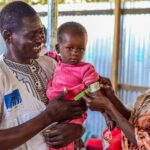Ibadan Explosion: How to rethink disaster preparedness and responsiveness
“In the face of disaster, individuals and communities are the true first responders. Preparedness starts with us."
Author: Sunday Nto, Sydani Institute for Research and Innovation Tweet
These are the wise words of Craig Fugate, the former Director of the Federal Emergency Management Agency, a man who strongly held to the philosophy of decentralized disaster management. In our context, this raises some pertinent questions; what are the roles of individuals and communities in disaster management? Is it possible to optimize disaster management in Nigeria, and make it citizen-driven?
On January 16, 2024, a catastrophic explosion occurred in Bodija, a district in Ibadan, Oyo State, Nigeria1-3. Bodija is a lush residential estate established by the Western Nigeria Region following Nigeria’s independence. Most of the early homeowners were diplomats, judges, professors, and high-ranking civil servants. The explosion inflicted severe property damage and the loss of life. As of January 18, the death toll had risen to 5 persons, while about 77 people were hospitalised with varying degrees of injuries4-6.
Although the report from the full investigation about the primary cause of the explosion is yet to be publicly disclosed, the governor of Oyo State, His Excellency, Engr. Seyi Makinde has communicated that “preliminary investigations by the security agencies revealed that illegal miners occupying one of the residential buildings in Bodija stored explosive devices there, which instigated the blast”7-8.
The explosion in Bodija, Ibadan, is not an isolated event. In 2020, a similar explosion occurred in Akure, which caused widespread damage, including the destruction of over 100 residential buildings, a school, and churches 9–10. It also reignites memoirs of the Ikeja Military Cantonment bomb blast in Lagos on January 27, 2002. Triggered by a Mammy Market fire, the explosions claimed over a thousand lives, rendering thousands homeless. The panic-induced stampedes led to additional casualties, particularly near the Oke-Afa canal, where around 1,000 people drowned.
These are only a few of several related events when listing the number of man-made disasters that have caused a huge loss in Nigeria. These events emphasize the necessity for proactive measures and rethinking of the current disaster management structures in Nigeria.
Why is disaster management important?
The United Nations 11 defines disaster as a major disruption of the operation of a community or society that involves extensive human, material, economic, or environmental repercussions that exceed the affected community’s or society’s ability to manage using its resources. It is an event, natural or man-made, sudden or progressive, that impacts with such severity that the affected community has to respond by taking exceptional measures.
Simply defined, disaster management is the systematic observation and analysis of disasters to improve measures relating to prevention, mitigation, preparedness, emergency response, and recovery12. It is important to discuss disasters and their management for many reasons. First, SDG 12 seeks “to reduce risk and build resilience to disasters for all.” This is premised on the universal understanding and acceptance that disasters can erode and destroy the development gains of individuals, communities, states, and even countries13. Hence, reducing the risks of disasters (for example, mitigation, preparedness, and early warning systems) for predictable events and man-made severe conditions such as material explosions help to protect both human and economic assets.
Additionally, Nigerians have become increasingly exposed to a wide range of hazards14. This is a culmination of several factors including poverty, population growth and distribution, and the condition of human settlements and their infrastructure. Other causative factors include the level of environmental degradation, the level of public awareness, the dynamics of public policy, and the environment in disaster management.
How can we rethink disaster preparedness and responsiveness as citizens?
Following the understanding of the high risk and vulnerability level of Nigerians to disaster, the federal government of Nigeria, through the National Disaster Management Preparedness Plan, has ensured the existence of disaster management structures across all tiers of governance (federal, state, and local) in Nigeria. This is centered on the principles of shared responsibility and the need to ensure proper integration and collaboration among stakeholders. These structures include the National Emergency Management Agency (NEMA) at the federal level, the State Emergency Management Agency (SEMA) at the state level, and the Local Emergency Management Authority (LEMA) at the local government level.
Although one understands the importance of strengthening the institutional capacities of these structures, rethinking disaster preparedness and responsiveness goes beyond them and is more about ensuring that individuals and communities understand and take ownership of the entire phase of disaster management (e.g., mitigation, preparedness, response, and recovery) to reduce risk and build resilience to disasters.
Mitigation
Mitigation operations are primarily conducted before and after emergencies. This encompasses all acts that either prevent an emergency, minimize the likelihood of an emergency occurring or mitigate the negative effects of inevitable emergencies. For instance, purchasing flood and fire insurance for your house is a mitigating strategy. To reduce the risk of fire in your home, choose building materials, wiring, and appliances that meet safety regulations.
Additionally, the communities, estates, etc need to develop and enforce building codes, conduct risk assessments, implement land-use planning to avoid high-risk areas, and invest in infrastructure improvements for disaster resilience. However, a fire-related accident is not impossible. Fire insurance can protect you from the high cost of rebuilding after a fire.
Preparedness
Fundamentally, preparedness efforts take place before an emergency happens. This comprises planning or preparations made to save lives and assist with response and rescue activities. Preparedness includes creating a family emergency plan, assembling an emergency kit, staying informed about local hazards and evacuation routes, and participating in community drills. Additionally, preparedness tactics include posting emergency phone numbers, conducting disaster simulations, and installing smoke detectors. Furthermore, communities should develop and communicate emergency plans, conduct drills and exercises, establish warning systems, and provide educational programs to inform the public about disaster preparedness.
Responsiveness
This includes efforts made to save lives and prevent additional property damage during an emergency. The response is to put your preparedness measures into action. Response activities include seeking shelter during a storm and turning off gas valves during an earthquake. In essence, reactionary actions occur during an emergency. It is very important to understand that your safety and well-being in an emergency are determined by your level of preparedness and how you respond to a crisis. Being able to act responsibly and securely will allow you to protect yourself, your family, and those around you. Examples of safe responses include taking cover and holding tight in an emergency, going to the basement, following emergency instructions, evacuating if necessary, providing first aid, and assisting neighbors in need.
Recovery
Primarily, recovery activities typically take place following an emergency. This comprises actions taken to return to normal or even safer conditions after an emergency. Recovery includes receiving financial aid to help pay for repairs. After an emergency, once the immediate danger has passed, your continued safety and well-being will be determined by your capacity to adjust to your new life and surroundings. During the rehabilitation period, you must look after yourself to avoid stress-related illnesses and financial strain. During the rehabilitation process, you should also explore steps to reduce or mitigate the effects of future calamities. Additionally, communities should coordinate long-term recovery efforts, provide financial assistance to affected individuals and businesses, rebuild infrastructure, address mental health needs, and implement measures to enhance resilience for future disasters.
A Call to Action
It is important to note that despite progress made by NEMA to improve public awareness, there is still work to be done in Nigeria to strengthen citizen-driven disaster management further. Factors such as funding and other resource constraints, slow responses; and lack of collaboration among NEMA and other agencies contribute to the weak disaster management in Nigeria. However, Nigeria can foster citizen-driven disaster management by borrowing learnings from the “Jichikai” or “Neighborhood Associations”15 in Japan, the Community Emergency Response Team (CERT)16 in the USA, and the “Get Ready” campaign in Australia17.
International organizations (e.g United Nations Office for Disaster Risk Reduction (UNDRR); Global Facility for Disaster Reduction and Recovery (GFDRR); Center for Disaster Philanthropy (CDP); et.c) can play a crucial role in facilitating citizen-driven disaster management efforts in Nigeria by supporting infrastructure development, early warning systems, and community-based initiatives. Additionally, joint research initiatives between Nigerian organizations and international organizations can enhance understanding of local vulnerabilities and contribute to the development of effective disaster management plans.
Generally, as the mantra says, “Security is everyone’s business, “ So is disaster management. All hands must be on deck to ensure that we properly mitigate, plan, and respond to emergencies.
References
- Sanni., S (2024). Nigeria blast kills two, dozens hurt as buildings collapse (Online). Available at: https://www.reuters.com/world/africa/nigeria-blast-kills-two-dozens-hurt-buildings-collapse-2024-01-17/ (Accessed: 19th Jan. 2024)
- Igwe., I (2024). Ibadan Explosion Death Toll Rises To Five – Oyo Govt (Online). Available at: Channels TV (Accessed: 19th Jan. 2024)
- Okedare., A (2024). Ibadan explosion in Nigeria: ‘The roof fell on my mother in bed’ (Online). Available at: https://www.bbc.com/news/world-africa-68002936 (Accessed: 19th Jan. 2024)
- The Cable (2024). Death Toll from Ibadan Explosion Increases to Five (Online). Available at: https://www.thecable.ng/death-toll-from-ibadan-explosion-increases-to-five (Accessed: 19th Jan. 2024)
- Oluwuyi , F. (2024). Ibadan Explosion: Death toll rises to five (Online). Available at: Premium Times (Accessed: 19th Jan. 2024)
- Akinola, I (2024). Ibadan Explosion: We didn’t know someone was storing explosives, Estate Secretary, Ogini recounts (online) Available at Tribune Online (Accessed: 19th Jan. 2024)
- Adesanya., A (2024). Governor Blames Illegal Miners for Ibadan Explosion( Online). Available at: https://businesspost.ng/general/governor-blames-illegal-miners-for-ibadan-explosion/#google_vignette (Accessed: 19th Jan. 2024)
- Johnson, D., Obinna, C., Akoni, O., Agbakwuru, J., Elijah, L., Badru, D., Abubakar, S., Ewepu, G., Ogunnaike, J., and, Eromosele, F., (2024) (online). Available at: Illegal miners’ explosives caused Ibadan blast — Makinde (Accessed: 19th Jan. 2024)
- Vanguard Newspaper (2024). BREAKING: Explosion destroys 100 houses, schools, churches in Akure (Online) Available at: Vanguard Online (Accessed: 19th Jan. 2024)
- Osinusi F (2024). BREAKING: Explosion rocks Akure, many houses, schools, churches destroyed (Online). Available at: Tribune Online (Accessed: 19th Jan. 2024)
- 11. United Nations Office for Disaster Risk Reduction. Terminology (2024): Sendai Framework Terminology on Disaster Risk Reduction (Online). Available at: Disaster | UNDRR (Accessed On 19th Jan. 2024)
- Sawalha, I.H., (2023). Evolution of modern disaster management. foresight. Sawalha, I.H., 2023. Evolution of modern disaster management. foresight.
- United Nations (2012). Disaster Risk and Resilience (Online). Available at: United Nations (Accessed On 19th Jan. 2024)
- Food And Agriculture Organisation (2016). National Policy On The Environment (Revised 2016). Available at: https://faolex.fao.org/docs/pdf/nig176320.pdf (Accessed On 19th Jan. 2024)
- Yamamuro, A., (2024). From Dichotomous Interpretations to Spectrum Thinking: Formation of a Community Organization in a Nuclear Host Locality. In Everyday Life-Environmentalism (pp. 91-104). Routledge.
- Snyder, A.M., Ciottone, G.R. and Gebhart, M.E., (2024). Disaster and Emergency Management Programs. In Ciottone’s Disaster Medicine (pp. 135-139). Elsevier.
- New South Wales Government (2023). New resource helps NSW ‘Get Ready’ for disasters. (Online). Available at: Prevention Web (Accessed On 19th Jan. 2024).



